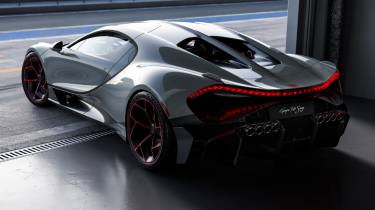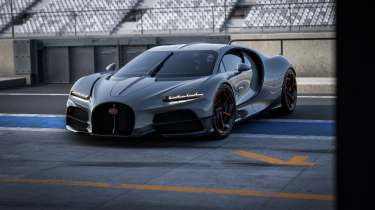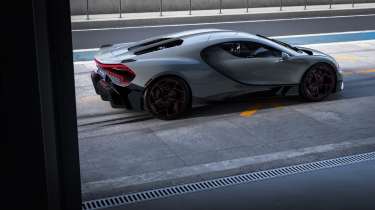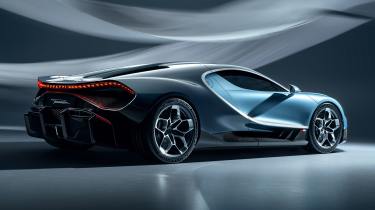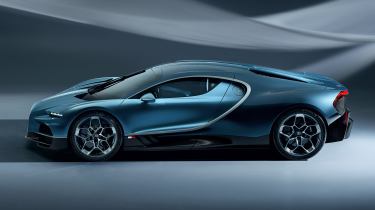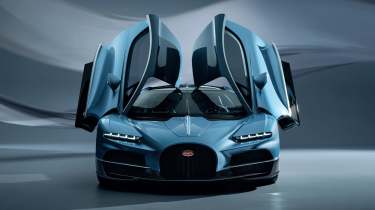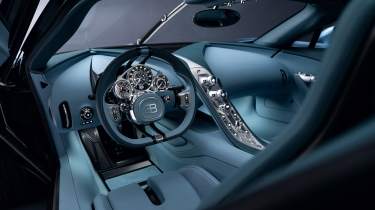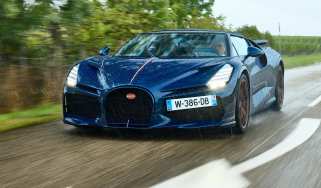Bugatti Tourbillon hypercar gets £185k Équipe Pur Sang upgrade package
Bugatti reveals motorsport-inspired upgrades for its Cosworth naturally aspirated V16-powered 273mph hypercar
As Bugatti Tourbillion customers begin to spec their exclusive 1775bhp €3.8 million hypercars Bugatti has revealed a motorsport-themed ‘Équipe Pur Sang’ configuration as one possible personalisation option. It pays homage to what the company calls the ‘Tourbillion’s incomparable performance and Bugatti’s motorsport history.’
While no two Tourbillion’s will likely leave the factory with identical spec sheets the Équipe Pur Sang option – literally translated as ‘Thoroughbred Team’ – features aerodynamic revisions in the form of a front splitter and a bespoke rear wing with small endplates to improve aero efficiency. These are paired with a revised rear diffuser that’s said to improve downforce.
If the standard – if there is such a thing when talking about a multi-million-pound hypercar – Tourbillion’s partially hidden quad oblong exhausts don’t signify the car’s prodigious power output then the Équipe Pur Sang addresses that with a new eight-exhaust pipe configuration. The wheels are new too, 20-inches at the front and 21-inches at the rear, and feature long thin spokes that have been designed to reduce turbulence and enhance airflow to the rear radiator for an eight per cent increase in cooling.
Inside Bugatti has equipped the Équipe Pur Sang with a performance seat option for improved lateral support and these are swathed in black Alcantara with red detailing while the rest of the cockpit is treated to Black Poli trim parts and what it terms the medium carbon interior package.
While the Equipe Pur Sang option will no doubt pique the interest of Bugatti’s customers it’s the Tourbillion’s mechanical specification that’s most enthralling and while we haven’t driven it yet, we have been able to get up close with the hypercar to drink in, and discover more about, its fascinating details.
> Cosworth's secret: behind the scenes at the firm behind Bugatti, Aston Martin and F1 engines
The very fact that the naturally-aspirated super-engine is far from dead – witness recent machinery from Aston Martin, GMA, Ferrari and now Bugatti – is something to be celebrated. And with its 986bhp 8.3-litre V16 engine the new Bugatti Tourbillon would appear to be a force of nature.
Bugatti Tourbillon – details on the 1775bhp Cosworth V16 hypercar
There is a nod to modernity to the Tourbillon’s powertrain in that it is also equipped with a front e-axle powered by two electric motors, with a third electric motor mounted on the rear axle. Combined they deliver an additional 789bhp to give the Tourbillon its headline 1775bhp power figure. It’s also a hypercar with a €3.8 million price tag with production limited to 250 units, with spin-off derivatives to follow when production starts in 2026.
‘Some thought we might combine a Nevera with a Chiron’ says Bugatti boss Mate Rimac, ‘but that wouldn’t be a Bugatti. And our customers like the emotion of an internal combustion engine and I have to build cars our customers want to buy'. The Tourbillon's mechanical layout was first devised in 2020, when Rimac built a scale model featuring a V16 engine supported by three electric motors – having pitched the idea he got the green light to make the concept a reality.
A pure internal combustion engine for the Tourbillon was ruled out on the grounds it wouldn’t deliver a performance advantage over the Chiron, so too did any notion to hybridise the proven turbocharged 8-litre W16 engine, primarily because the weight would have spiralled out of control. Removing the turbos to make the W16 a naturally aspirated motor was also discarded because the height of the engine and its layout compromised the design and packaging of the new model.
The new 90-degree cross-plane crank V16 weighs 252kg less than the outgoing W16 despite measuring 29mm longer and being a metre in total length. It sits lower in the chassis and, unlike the W16, which was developed and built in house by VW, the V16’s design, development and construction has been undertaken by Cosworth.
The engine drives through an eight-speed DCT and there's an e-motor at the rear (along with an e-LSD) that hangs off the back of the gearbox generating 250kW and 450Nm. The two front motors each produce 250kW and 221lb ft and all are powered by a 25kWh oil-cooled 800-volt battery that’s housed in the transmission tunnel and behind the passenger cell, forming a structural part of the monocoque. Each motor can spin up to 24,000rpm, with the e-axles delivering over 6kW per kg of e-axle mass, which includes the inverters, motor and gearboxes.
Bugatti’s latest powertrain sits in a new carbon monocoque, which includes a Formula 1-inspired rear diffuser that forms part of the crash structure and underfloor of the car, hence why it’s two metres in length. The suspension is multi-link front and rear with dual valve damper technology, and the hardware is 45 percent lighter than the Chiron’s. New bespoke Michelin Pilot Sport Cup 2 tyres (345/30 x 21 on the rear, a 285/35 x 20 on the front) are fitted as standard.
All this makes for, as you’d expect, some remarkable figures: a claimed sub two-second 0-62mph time (pipe down Plaid owners), less than five seconds to reach 120mph, under ten to crack 180mph, less than 25 seconds to reach 240mph before it’s all done (a relative term, obviously) at 276mph, although Mate points that this isn’t the maximum and there’s more to come. On top of this, it will cover up to 37 miles on electric power and charge from zero to 80 percent in 12 minutes.
On current emissions regulations it's 25 percent cleaner than a Chiron, and despite the 300kg hybrid system it weighs a comparable 1995kg. The Tourbillon uses lighter componentry than its predecessor – including the combustion engine and 3D-printed suspension parts – to achieve this.
It also sits 33mm lower than a Chiron yet has the same internal dimensions. Inspired by the Type 57C and 35 from Bugatti’s past, Director of Design Frank Heyl has taken the modern Bugatti design language and blended it with traditional cues. It’s unmistakably a modern Bugatti but there’s also more function and detail in the Tourbillon’s surfaces, a tension that portrays the performance encased within. The philosophy was to improve on what had gone before, not to redesign for the sake of it. Think iPhone, Rolex Daytona and the Porsche 911.
Aerodynamics are a large factor in the Tourbillon’s design. There’s a wing, naturally, but it’s not the primary source of downforce at the rear – that role is taken by a diffuser beginning at the rear of the passenger cell and running either side of the engine (which is narrower than the W16, allowing for bigger venturi tunnels). The rear wing doubles as an air brake and is electronically controlled rather than hydraulic to save weight.
The inside is equally as bespoke and distinctive as the exterior, your eyes immediately drawn to the instrument dials positioned on top of the steering column. If you’re wondering where the name for Bugatti’s latest model came from you’ll work it out the moment you see the dials. Inspired by the horlogerie philosophy, the instrument display is Swiss watchmaking in automotive form. Constructed from titanium, the cluster weighs just 700g and is made up of more than 600 parts with the smallest measuring just five microns. As you turn the outer wheel rim, the dials and centre boss of the wheel stay in position.
It’s a mesmerising piece of design engineering, although hopefully not too distracting as you crack the magic double-ton. The left-hand instruments are for coolant, fuel and EV power and use 160 individual parts, the central speedo and rev counter consisting of 250 parts with 150 LEDs to illuminate it all. To the right is Bugatti’s trademark power dial.
Screens are all but banished in the Tourbillon. The floating centre console is machined from a single piece of billet aluminium to create its skeletal design and uses ‘Boheim’ crystal glass. The only screen in the car is no larger than an iPhone’s and sits at the top of the console and retracts when not in use.
The floor-hinged pedal box moves while the seat is fixed, although the backrest and base are adjustable for comfort. The drive mode control is a rotary dial on the steering wheel and every detail throughout the interior is exquisite, the type of jewellery your mum told you not to touch even when you didn’t have sticky fingers.
In the hypercar world Bugatti has often been portrayed with a quiet confidence in everything it does. While others have chased lap times, top speed, exclusivity or all three it has remained focused on its objectives. In the Tourbillon that focus eclipses all that has gone before, and customers will feel the results of this when deliveries commence in 2026.
